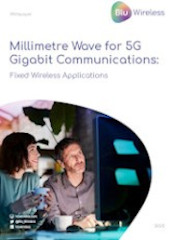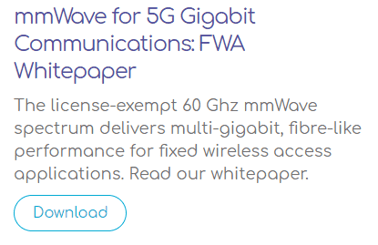Fixed Wireless Access (FWA) is the answer to the full-fibre problem. This revolutionary technology will finally meet the high-performance connectivity needs for entire cities and rural areas.
Nations globally – and particularly the United States – are reaping the benefits of cost-effective, high performance networks which are achieved through unlicensed mmWave 5G. Deployment in the UK and Europe is also far from a pipe dream. In fact, it can happen today.
For consumers and operators alike, this is truly transformative. With universal access to fibre-like internet speeds, society can become more skilled, more productive and more efficient. The digital divide can be bridged. Communities can become more interconnected than ever before.
The demand for FWA is rising fast
Society needs broadband that supports the demand from data-rich applications for streaming entertainment and affordable, convenient delivery of public services already and the future will see this demand increased ten-fold. Implementing 5G now will not only satiate needs in the present, but ensure the supply of reliable connectivity for the future. Unlicensed 5G mmWave contributes both technical capability and economic flexibility towards meeting this need.
One of the leading use cases for mmWave adoption is implementing FWA for the delivery of cost-effective multi-gigabit broadband networks. Using the licensed exempt mmWave spectrum means that it’s possible to deliver cost-effective, fibre-like performance.
Consumer demand for fibre-grade internet connectivity is also on the rise, demonstrating the need for FWA infrastructures and the improved capabilities that come with it. As of 2019, the projected demand for speeds is predicted to rise from 100 to 1,000 Mbps per household and customer usage from 90M in 2019 to 150M by 2023.
What is the technology making all this possible?
FWA is made up of a large network of distribution nodes, each emitting their own hotspot. These nodes are easily installed at external locations, such as lampposts, and connect to receivers placed on homes. This solution creates a wide-range wireless mesh network that can provide reliable broadband to multiple homes using millimetre waves.
At the source of this is a Distribution Network (DN) node connected to the main network which uses beam forming to support fibre-like, wireless connectivity for multiple homes. With line of sight (LOS) wireless beams and high-performance connections dedicated to each individual home, this technology mitigates interference issues, reduces high deployment cost, and consequently, high consumer costs.
The HYDRA1.0 mmWave modem system engine from Blu Wireless was designed from the outset to meet these requirements for ‘Carrier Grade’ broadband telecom applications. A dual mmWave modem based on HYDRA1.0 is in production now as well as a single modem in development for reduced cost and power which will be sampled in 2020. A complete chipset solution using our module hardware and associated software is also in production. This is designed for urban wireless mesh networks and delivers an unprecedented throughput of 12 Gbps per node.
The same mesh network can also be used to connect 4G LTE Small Cells to the core network for use as a cost-effective backhaul connection mechanism. This will be necessary as the scale of data being processed continues to rise alongside connectivity capabilities.
Read more in our Whitepaper
The global market is evolving
In the UK, FWA is generally categorised as low-bandwidth rural technology (100Mbps), using bands below 6GHz. However, its potential to go beyond this has been proven and is now widely recognised. For example, in the United States, licensed exempt mmWave FWA is considered a viable, budget alternative to fibre broadband.
Currently less than 5% of UK homes have full fibre connectivity, which is drastically low when compared with Portugal’s 89% and Spain’s 71%. In a strategic campaign to improve national broadband coverage and keep up with global connectivity, the UK Government has pledged to deliver full-fibre broadband to the whole of the UK by 2033.
They are working towards meeting this promise by investing into various unlicensed mmWave FWA testbeds across the country. For example, Blu Wireless is collaborating with other industry experts on various projects to drive this development and bring UK FWA technology to the forefront of connectivity innovation. We have been a key partner in the £3.5M DCMS funded project in Liverpool exploring the use of 5G to create a smarter city for the benefit of health and social care and to reduce the digital divide.
Outside of the UK FWA applications are already booming. Carriers across the globe have been deploying and testing unlicensed mmWave FWA networks. Some of the most prominent deployments to date include the following:
- Facebook: Terragraph network in San Jose, USA.
- Vivint Wireless: Deployment in Draper, Utah USA and Phoenix, USA.
- Reliance Jio: trial in Mumbai, India.
- Deutsche Telecom: Trial in Hungary.
- YTL: Deployment in Penang, Malaysia.
A significant discovery from these tests is that medium density housing areas are the most economically attractive conditions for deploying this technology. End customer costs are $30-$50 in comparison with $1,000 per home for the equivalent fibre costs, proving the business case for wireless mmWave deployment.
What does this mean for consumers?
FWA technology is making fibre-grade performance possible at a fraction of the cost by capitalising on wireless 5G mmWave. This technology is also stronger, better and faster, supporting multiple devices which perform data-heavy tasks as standard.
This will provide greater choice for consumers, better value broadband deals and higher performance connectivity.











